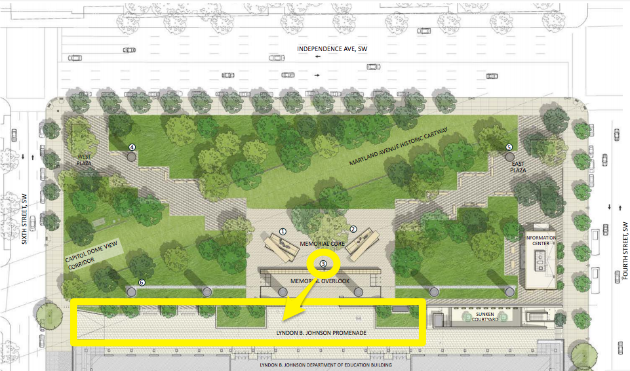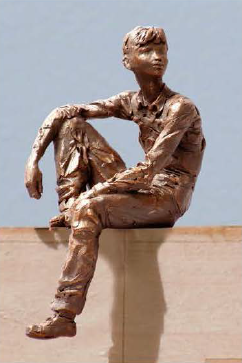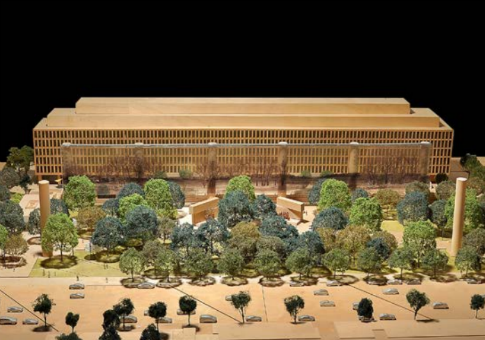The Eisenhower Memorial Commission voted late last week to approve another round of modifications to the trouble-plagued design submitted by architect Frank Gehry.
In a brief meeting on Capitol Hill, members of the commission learned about the new design from architecture firm Gehry Partners.
The commissioners approved the new plan, which relocates a controversial statue of a young Dwight Eisenhower to a spot behind the memorial. The statue, which depicts Eisenhower as a farm boy gazing expectantly into the future, had been located in a position of prominence at the center of the memorial.
The commission agreed to relocate the statue out of view from the memorial park. It will be placed near information kiosks in a promenade to the south.

The statue, which was the only standalone statue of Eisenhower when it was introduced into the design in 2011, became a focal point of controversy. Critics said it cut "a great man down to size" and was irrelevant to the purpose of the memorial, which is to honor Eisenhower's achievements as president and general.
Gehry and the commission continue to argue that the statue recognizes Eisenhower's Kansas roots. Craig Webb, a representative of Gehry Partners, said Thursday that the statue of boy Eisenhower would inspire young visitors.
The new design also changes the subject matter of the eight-story metal tapestry that looms over the memorial core. A panoramic picture of the Normandy beaches, which Eisenhower chose as the site of the Allied invasion of Europe, will now serve as the basis for the tapestry. The picture captures the beaches in peacetime to emphasize Eisenhower's role in ending World War II and starting an era of peace in Europe.
In the original design, the steel-mesh tapestry depicted Kansas farmland.
Critics have reserved their strongest words for the metal tapestry, saying it evokes an "Iron Curtain," and that its fine steel strands are not a suitable material for a landscape.
The modifications were negotiated by former secretary of state James Baker, acting on behalf of the commission, and the Eisenhower family. Eisenhower's descendants did not support the modernist design for years because they thought it was too experimental and grand for the famously austere Eisenhower. They agreed to support the design once modifications were made.
"We are pleased with the design modifications recently made by Frank Gehry," said Sen. Pat Roberts (R., Kansas), a member of the Eisenhower Memorial Committee, in a statement. "We feel they further capture Dwight D. Eisenhower’s broad range of contributions to our nation and the world, in times of both war and peace."

Opponents interpreted the new modifications as a small victory, but said Gehry's experimental design remains unsuitable for a memorial.
"It's a definite improvement that the kitschy teenage Ike statue has been banished to the rear of the memorial," said Justin Shubow, president of the National Civic Art Society. "However, the rest of the design changes are wholly superficial. The steel screen and smokestack-like columns are as ugly and gargantuan as ever."
Now that Eisenhower's family supports the design, the Eisenhower Memorial Commission may have the momentum it needs to end a years-long stalemate over the memorial. Still, the $150 million project will have to overcome lukewarm public support and significant fundraising shortfalls.
"There still is no evidence that Congress is willing to fund Gehry's fiasco. Nor is there any evidence that the public likes the design," Shubow said.
This is not the first time the Eisenhower memorial has revised controversial design elements. In response to public outcry, Gehry in 2012 added larger-than-life statues of Eisenhower as president and Supreme Allied Commander. Gehry in 2014 scrapped two additional metal tapestries.
CORRECTION, Dec. 8 2:35 P.M.: This article has been corrected to note that the statue of Young Eisenhower is not barefoot; Frank Gehry envisioned the statue as barefoot in the early stages of the project. The statue first appeared in the memorial design in 2011, not 2010. The statues of Eisenhower as president and Supreme Allied Commander were added in 2012, not 2014.
